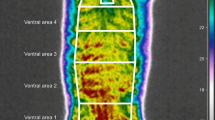Summary
The social Damara mole-rat Cryptomys damarensis (124 g), has a mean (±SD) resting metabolic rate of 0.57±0.09 cm3 O2 g-1 h-1, within a thermoneutral zone of 27–31° C. This rate of metabolism is 43% lower than that predicted by the curve for rodents, and 29% lower than that predicted by the subterranean rodent curve. These data support the hypothesis that the resting metabolic rates of social and solitary subterranean rodents are lower than those of solitary species inhabiting mesic habitats. These low resting metabolic rates may represent an energy-saving adaptation to aridity. The energetic cost of burrowing, in relation to the dispersion patterns of food in arid habitats, may explain these low metabolic rates.
Similar content being viewed by others
References
Ar A, Arielli R, Shkolnik A (1977) Blood-gas properties and function in the fossorial mole rat under normal and hypoxic-hypercapnic atmospheric conditions. Respiration Physiol 30:201–218
Arieli r (1979) The atmospheric environment of the fossorial mole rat (Spalax ehrengergi): effects of season, soil texture, rain, temperature and activity. Comp Biochem Physiol 63A:569–575
Arieli R, Ar A (1981) Blood capillary density in heart and skeletal muscles of the fossorial mole-rat. Physiol Zool 54:22–27
Arieli R, Ar A, Shkolnik A (1977) Metabolic responses of a fossorial rodent (Spalax ehrenbergi) to simulated burrow conditions. Physiol Zool 50:61–75
Arieli R, Arieli M, Heth G, Nevo E (1984) Adaptive respiratory variation in 4 chromosome species of mole-rats. Experientia 40:512–514
Bartholomew GA, Lighton JRB, Louw GN (1985) Energetics of locomotion and patterns of respiration in tenebrionid beetles from the Namib desert. J Comp Physiol 155:155–162
Bradley WG, Yousef MK (1975) Thermoregulatory responses in the Plains Pocket gopher, Geomys bursarius. Comp Biochem Physiol 52A:35–38
Bradley WG, Miller JS, Yousef MK (1974) Thermoregulatory patterns in Pockets gophers. Physiol Zool 47:172–179
Chapman RC, Bennett AF (1975) Physiological correlates of burrowing in rodents. Comp Biochem Physiol 51A:599–603
Darden TR (1972) Respiratory adaptations of a fossorial mammal, the Pocket gopher, (Thomomys bottae). J Comp Physiol 78:121–137
Dawson TJ, Hulbert AJ (1970) Standard metabolism body temperature, and surface areas of Australian marsupials. Amer J Physiol 218:1233–1238
De Graaff G (1972) On the mole-rat (Cryptomys hottentotus damarensis) (Rodentia) in the Kalahari Gemsbok National Park. Koedoe 15:25–35
Du Toit JT, Jarvis JUM, Louw GN (1985) Nutrition and burrowing energetics of the Cape mole-rat Georychus capensis. Oecologia (Berlin) 66:81–87
Ellerman JR (1956) The subterranean mammals of the world. Trans Roy Soc South Africa 35:11–20
Gettinger RD (1975) Metabolism and thermoregulation of a fossorial rodent, the Northern Pocket gopher (Thomomys talpoides). Physiol Zool 48(4):311–322
Gorecki A, Christov L (1969) Metabolic rate of the Lesser molerat. Acta Theriol 14:441–448
Haim A, Fairall N (1986) Physiological adaptations to the subteranean environment by the mole rat Cryptomys hottentotus. Cimbabasia 8(6):49–53
Hayssen V, Lacey RC (1985) Basal metabolic rates in mammals: taxanomic differences in the allometry of BMR and body mass. Comp Biochem Physiol 81A:741–754
Jarvis JUM (1978) Energetics of survival in Heterocephalus glaber (Ruppell), the Naked mole-rat (Rodentia: Bathyergidae). Bulletin of Carnegie Museum of Natural History 6:81–87
Jarvis JUM (1981) Eusociality in a mammal: cooperative breeding in Naked mole-rat colonies. Science 212:571–573
Kenagy GJ, Vleck D (1982) Daily temporal organization of metabolism in small mammals: adaptation and diversity. In: Vertebrate Circadian Systems. Aschoff J, Daan S, Groos G (eds) Springer Berlin, Heidelberg, New York 322–338
Lighton JRB (1985) Minimum cost of transport and ventilatory patterns in three African beetles. Physiol Zool 58:390–399
Lovegrove BG (1986) Thermoregulation of the subterranean rodent genus Bathyergus. South African Journal of Zoology (in press)
Macmillen RE, Lee AK (1970) Energy metabolism and pulmocutaneous water loss of Australian Hopping mice. Comp Biochem Physiol 35:355–369
McNab BK (1966) The metabolism of fossorial rodents: a study of convergence. Ecology 47(5):712–733
McNab BK (1973) The rate of metabolism of the spiny rat, Proechimys semispinosus, with comments on the ecological factors that influence the basal rate of metabolism in rodents and lagomorphs. Bol Zool Biol Mar N S 30:93–103
McNab BK (1979) The influence of body size on the energetics and distribution of fossorial and burrowing animals. Ecology 60:1010–1021
McNab BK (1980) On estimating thermal conductance in endotherms. Physiol Zool 53:145–156
McNab BK, Morrison P (1963) Body temperature and metabolism in subspecies of Peromyscus from arid and mesic environments. Ecological Monographs 33:63–82
Morrison PR, Ryser FA (1952) Weight and body temperature in mammals. Science 116:231–232
Nevo A (1979) Adaptive convergence and divergence of subterranean mammals. Ann Rev Ecol Syst 10:269–308
Nevo A, Shkolnik A (1974) Adaptive metabolic variation of chromosome forms in mole-rats, Spalax. Experientia 30:724–726
Ogilby W (1838) Proceedings of the Zoological Society of London. Proc zool Soc Lond:5–15
Pearson OP (1947) The rate of metabolism of some small mammals. Ecology 28:127–145
Ross JP (1980) Seasonal variation of thermoregulation in the Florida Pocket gopher, Geomys pinetis. Comp Biochem Physiol 66A:119–125
Vleck D (1979) The energy cost of burrowing by the Pocket gopher Thomomys bottae. Physiol Zool 52:122–125
Vleck D (1981) Burrow structure and foraging costs in the fossorial rodent, Thomomys bottae. Oecologia (Berlin) 49:391–396
Withers PC, Jarvis JUM (1980) The effect of huddling on thermoregulation and oxygen consumption for the Naked mole-rat. Comp Biochem Physiol 66A:215–219
Zar JH (1974) Biostatistical Analysis. Prentice Hall, Englewood Cliffs, New Jersey
Author information
Authors and Affiliations
Rights and permissions
About this article
Cite this article
Lovegrove, B.G. The metabolism of social subterranean rodents: adaptation to aridity. Oecologia 69, 551–555 (1986). https://doi.org/10.1007/BF00410361
Received:
Issue Date:
DOI: https://doi.org/10.1007/BF00410361




